Welcome back to This Week in Apps, the Extra Crunch series that recaps the latest OS news, the applications they support and the money that flows through it all.
The app industry is as hot as ever, with a record 204 billion downloads and $120 billion in consumer spending in 2019, according to App Annie’s “State of Mobile” annual report. People are now spending 3 hours and 40 minutes per day using apps, rivaling TV. Apps aren’t just a way to pass idle hours — they’re a big business. In 2019, mobile-first companies had a combined $544 billion valuation, 6.5x higher than those without a mobile focus.
In this Extra Crunch series, we help you keep up with the latest news from the world of apps, delivered on a weekly basis.
This week we’re continuing to look at how the coronavirus outbreak is impacting the world of mobile applications, including the latest on the U.S. and other international efforts to develop contact-tracing apps, plus the use of live-streaming apps as fundraising tools, the impact of quarantine on iPad apps and more. We’re also tracking news related to Zoom’s latest backtrack, WhatsApp’s plans to enter the credit market, the Instagram pods discovery, TikTok best quarter (better than any app… ever), Facebook’s plan for virtual dating and more.
Headlines
Apple News hits 125M monthly active users
The COVID-19 pandemic has driven a significant increase in how many people are using Apple’s News app on their mobile devices, tablets and Macs. During Apple’s earnings call this week, the company revealed Apple News now sees over 125 million monthly active users in the U.S., Canada, the U.K. and Australia, up from 100 million in January. Apple, however, did not note how many were subscribed to its $9.99/month premium news service, Apple News+.
Apple & Google release first version of the exposure notification API
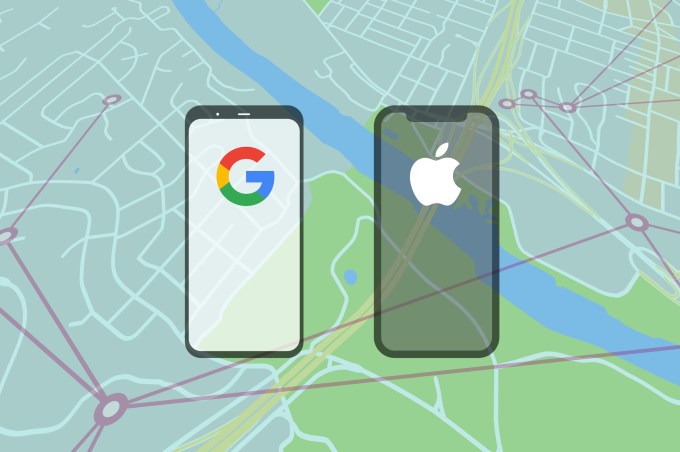
Image Credits: Bryce Durbin/TechCrunch
Apple and Google this week released the first version of their exposure notification API, previously called the contact-tracing API. The API is being made available to developers who will be tasked with creating new contact-tracing and notification apps on behalf of public health agencies, in order to gain feedback. The public release is due in mid-May, at which point Apple and Google’s app stores will be open to accept apps built using the new API.
Apple and Google have already provided an update with improvements focused on how the tech will function to protect user privacy, but there are already signs that a majority of Americans won’t use the apps, due to some Americans’ concerns over privacy. This is where the tech companies’ squandering of user trust over the years has gotten us, folks.
International contact-tracing apps in the news
Apple and Google’s joint effort to introduce an exposure notification is only one of the many contact-tracing projects in the works. And while the U.S. system is opt-in and anonymized, others are not:
- INDIA: In India, privacy advocates are concerned the country’s plans for its contact-tracing app, Aarogya Setu, which will hand out green, yellow and orange badges to indicate a user’s infection risk. They believe the tool could be used for state surveillance beyond the pandemic as it requires access to users’ location at all times. Indians aren’t legally required to install the app, but many will have to — including government employees. BuzzFeed this week reported how people were stopped from entering a pharmacy for medicine unless they showed security guards their app. Now, the government is asking smartphone makers to pre-install the app on devices. Indians may also have to have the app installed to use public transportation or take flights. So far, 75 million of India’s population of 1.3 billion have installed the app.
- FRANCE: The French government was planning to debate France’s contact-tracing app, StopCovid, but French Prime Minister Édouard Philippe said the discussion was too early as the app is not yet ready, and postponed the debate. The decision comes after hundreds of French cryptography and security researchers signed a letter to raise awareness about the potential risks of a contact-tracing app. The French government, like Germany, was going to use the ROBERT protocol. This uses pseudonymization to match contacts on a central server managed by a national authority — a cause for concern. Germany has since dropped plans to use ROBERT.
- GERMANY: Last Sunday, Germany reversed its stance on contact tracing. Instead of going for the centralized approach, the country has instead opted to adopt a decentralized architecture. Privacy advocates had raised concerns about allowing authorities to scoop up citizens’ data and warned of the potential for state surveillance further down the road.
- AUSTRALIA: More than 2 million people in Australia have now downloaded the country’s contact-tracing app, Bloomberg this week reported. The COVIDSafe app, like many others, uses digital handshakes between smartphones via Bluetooth. It allows health authorities to track who has been within 1.5 meters of an infected person for 15 minutes or more. The app is also facing privacy concerns, as 28% of Australians surveyed said they would not use the app. It needs 40% of the country’s 26 million people to use it to be successful.
- U.K.: More details about the contact-tracing app developed by U.K. authorities emerged this week. NHSX CEO Matthew Gould said future versions of the app could ask users to share location data to help epidemiologists identify hot spots. But the basic version being tested now won’t track location.
Was Zoom inflating its daily active user numbers?
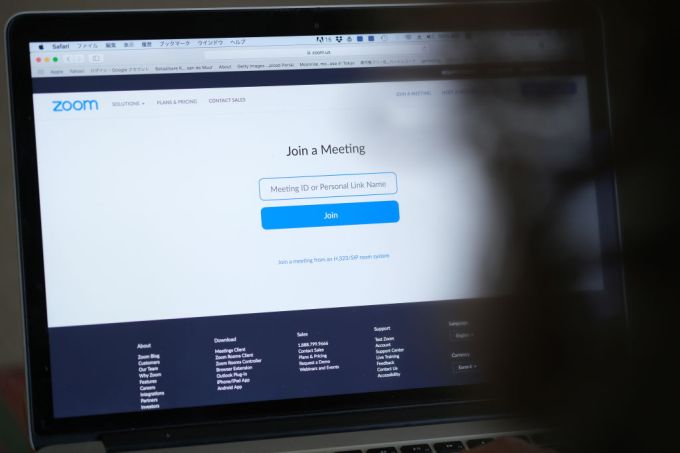
KATWIJK, NETHERLANDS – APRIL 4: In this photo illustration, the website of Zoom Video Communications Inc. is seen on April 4, 2020 in Katwijk, Netherlands. (Photo by Yuriko Nakao/Getty Images)
The coronavirus may have been good for Zoom’s business, but the increased attention on the company as a result has been bad for its reputation, possibly with long-term impacts. The company was already besieged by security problems, which it admitted to and said it would fix. This included an inaccuracy about the nature of encryption used in Zoom meetings — they were not end-to-end encrypted, despite what Zoom’s marketing said. Now it seems Zoom misstated its usage numbers, too. The company quietly changed a blog post which said it was seeing 300 million daily active users (DAUs) to read daily active participants. The latter would include meeting attendees, as well. That’s a big difference, as referencing participants inflates the number of people using the service.
Whoever is in charge of Zoom communications, just stop. You’re doing more harm than good.
What’s new in iOS 13.5, Beta 3
The latest iOS beta was released this week, most notably with the first version of the exposure notification API. But there were a couple of other improvements worth mentioning, as well, including a change to how Face ID works in the case that it detects the user is wearing a mask. It will then jump to the passcode-entry screen. While that’s useful for now, it’s not a solution in the post-COVID world. Apple needs to create devices that offer both Touch ID and Face ID, or even some other biometric security option, because no one — and I mean no one, will want to enter their passcode umpteen million times a day.
Another change in the new beta will allow users to disable the “automatic prominence” feature in FaceTime video calls so you have the option of seeing a static grid of all the call participants. Looks like some Apple engineers have been FaceTimeing a lot from home these past few weeks!
Apple Maps app gains COVID-19 testing sites
Apple this week added COVID-19 testing sites to its Apple Maps app across the U.S., covering all 50 states and Puerto Rico. The app will show all testing locations, including hospitals, clinics, urgent care facilities, general practitioners, pharmacies and more, as well as the dedicated COVID-19 testing sites. Apple also made COVID-19 a prioritized point-of-interest option when you go to search.
WhatsApp to enter into credit and lending market in India
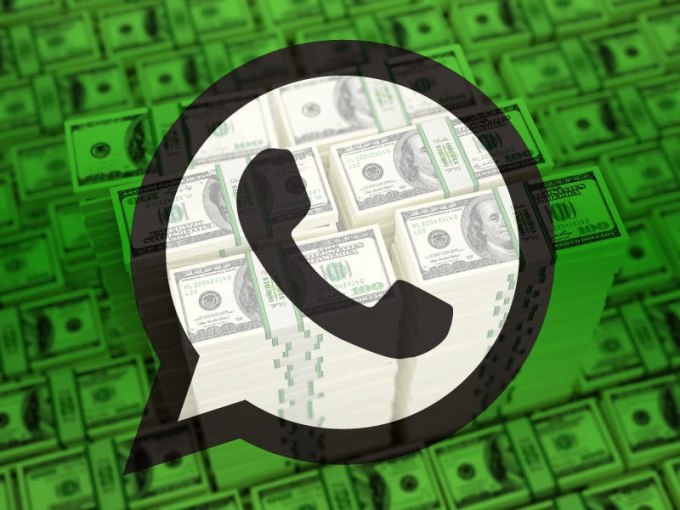
A filing with India’s regulators spotted this week disclosed that Facebook-owned WhatsApp is considering a move into credit and lending in the market. WhatsApp already has its foot in the door by way of its mobile payments interface, UPI or Unified Payments Interface, which includes payments. But that effort has been hung up by regulatory issues, and has only million to date.
Meanwhile, WhatsApp competitors are surging ahead with regard to their own payments and credit products.
Amazon, for example, just launched Amazon Pay Later (April 28), which offers a credit line to those who make online purchases or pay bills on its platform.
Facebook, which owns WhatsApp, sees the potential in India’s sizable and still emerging mobile market. The digital payments industry in the country alone is expected to hit $1 billion in 2023, for example.
To gain a further stake in India, Facebook this month invested $5.7 million in Jio Platforms, a subsidiary of Reliance Industries, to acquire a 9.99% stake in the business, one aspect of which is its large e-commerce platform, JioMart.
There are obvious ties between that deal and WhatsApp, where users already shop from merchants on the app and perhaps in the future could do so on a credit basis. Related to this, JioMart has begun testing an ordering system on WhatsApp that lets consumers shop for groceries and household items on the app.
TikTok is having a good quarantine: tops 2B downloads after having the best quarter for any app ever
According to Sensor Tower, TikTok generated more than 315 million new installs across the App Store and Google Play in Q1 2020. This is the most downloads for any app in any quarter since Sensor Tower started measuring the app stores in January 2014. Even Facebook at its peak of new installs only saw around 225 million in a quarter. Of course, the install base for smartphones was much smaller then.
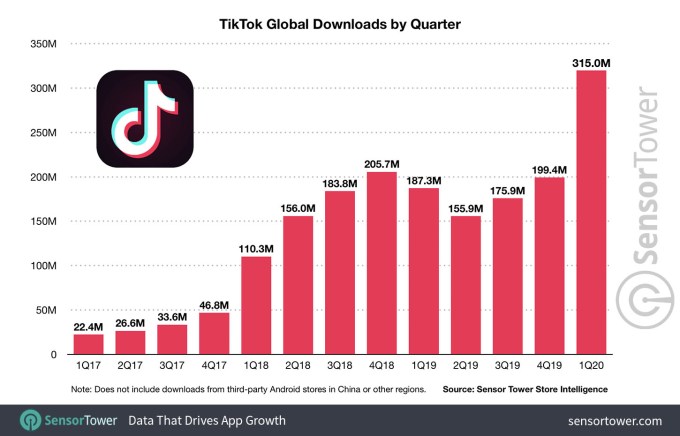
TikTok’s surge of installs was attributed in large part to Indian users, who were responsible for 30.3% of the installs. China (where the app is called Douyin) had 9.7% of installs, not including third-party Android app stores in the region. The U.S. rounded out the top three, with 8.2% of installs. Due to India’s influence, the majority of new installs came from Android (75.5%) versus the App Store (24.5%).
TikTok has now topped two billion total installs, and its lifetime user spending has risen to $456.7 million, more than 2.5 times the $175 million the app had generated when it reached 1.5 billion downloads just five months ago.
A separate report by eMarketer notes that TikTok added more than 12 million unique U.S. visitors in March, for a total of 52.2 million. And time spent in the app is up 10.8% in March over January in the U.S., for a total of eight hours per month.
The internet is fake, Instagram edition

Image Credits: Bryce Durbin/TechCrunch
Remember that article that revealed that much of the internet traffic and activity is fake — bots and fake clicks and fake accounts? Less than 60% of web traffic is human, and sometimes the scales tip in the bots’ direction, it said. Well, here comes another example of this dark reality.
Researchers at NYU this week identified hundreds of groups of Instagram users, some groups with thousands of members, who systematically exchanged likes and comments on each other’s posts in order to game the algorithm. The dumb ol’ algorithm sees this fake engagement as real, as it’s less obvious than automated bot traffic. This fake engagement helps boost the posts, which then leads to real, organic engagement thanks to the post’s increased visibility. The researchers found nearly two million posts had been manipulated in this way, with more than 100,000 users taking part in the groups, called “pods.” Some of the pods even charge for membership.
In other words, the users are now the bots and the algorithm can’t figure out what to do about it.
Users in pods would often leave generic comments, e.g. “nice pic,” which could be used to train algorithms to detect this less-than-authentic behavior.
Instagram and TikTok roll out live-stream fundraising
To capitalize on the increase in live-streaming and nonprofits’ need for cash amid the coronavirus pandemic, Instagram and TikTok within a day of one another introduced options that allow creators to raise funds for nonprofits with live-streaming to their followers. In TikTok’s case, the fundraising option can also be added to video posts. (And Instagram already had donation stickers for Stories.)
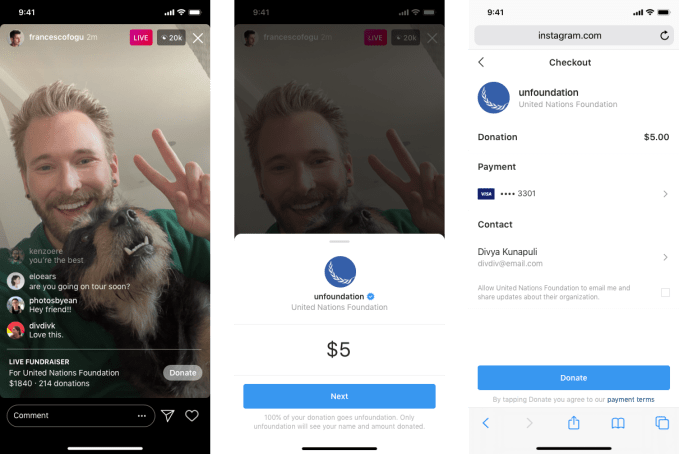
TikTok only supported a handful of charitable causes at launch. But Instagram says its Live Donations feature can be used to create fundraisers for over a million nonprofits.
iPad app downloads get a quarantine boost
Sensor Tower reports that first-time downloads of iPad apps topped 1.1 billion worldwide in Q1 2020 — the largest number of new app installs since Q3 2016 (1.16 billion) and up 52% from Q4 2019. The surge could be attributed to increased iPad usage during the quarantine. App installs were led by games, entertainment and education.
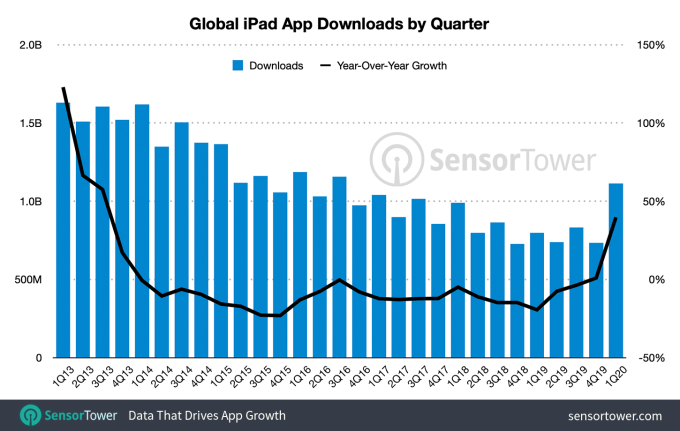
China ordered takedown of Slack-style office app
China’s regulator ordered ByteDance (TikTok parent company) to suspend downloads of its Slack-style app, Feishu, Bloomberg reported. The office collaboration tool had been offering a feature that allowed users to browse posts on foreign platforms, like Facebook and Twitter. The app had grown in popularity as a work-from-home solution during the pandemic. It competes with Alibaba’s DingTalk and other offerings from Tencent.
Facebook to launch ‘virtual dating’
Facebook is joining the video dating market. The company’s Facebook Dating service will soon launch a new video-calling feature that will allow users to connect and video-call over Messenger, as an alternative to going on a real-world date.

This sort of video option is already available on Bumble and on some Match-owned apps like Hinge and Match. Its PoF app offers live-streaming. Tinder, however, has not announced plans for video but Facebook’s move will surely push them in that direction, especially in a post-COVID world.
Tim Cook taught Warren Buffett how to use his iPhone
Better late than never? Berkshire Hathaway CEO Warren Buffett, whose company holds the largest stake in Apple, said he received personal instruction from Apple CEO Tim Cook on how to use his iPhone, but still doesn’t quite get it. He says he sometimes struggles to make calls with the device and never uses apps. Buffett made the comments in an episode of Yahoo Finance’s weekly interview series, “Influencers with Andy Serwer.” The billionaire Apple investor only in February upgraded from his $20 flip phone to an iPhone 11.
Funding and M&A
- Tinvio, a communication platform for supply-chain merchants raises $5.5 million seed. The company consolidates in one app a merchant’s orders from email, SMS and WhatsApp, as well as creator a digital ledger to track invoices, finances and fulfillment.
- Figma, a collaborative design platform which, among other things, can be used to design and prototype apps, raised $50 million in Series D funding, led by Andreessen Horowitz.
- Online design community Dribbble, where many mobile designers share their work and concepts, acquired Creative Market, a marketplace for ready-to-use fonts, icons, illustrations, photos and other design assets. Deal terms were not revealed, but the move brings Dribbble to 12 million users.
- Mobile gaming startup Scopely acquired PierPlay, the co-creator of its “Scrabble Go” word game launched in January. The company raised $200 million last month for M&A.
- Mobile-first challenger bank Finom, headquartered in Berlin, raises $7 million seed led by Target Global, with participation from General Catalyst.
- Challenger bank for SMBs, Wise, raises $5.7 million seed led by Base10 Partners for its small biz banking service that bundles Stripe and banking. The service runs in the browser as well as in apps for iPhone, iPad and Android.
- NY-based investing app Stash raises $112 million led by Lending Tree for its mobile-first route to money management. The company reports 4.5 million users and $1 billion in assets under management.
- League of Legends developer Riot Games acquired Hypixel Studios, whose first title, Hytale, is expected in 2021. The game is described as a “community-powered block game that combines the scope of a creative sandbox with the depth of a roleplaying game.” Or, as Polygon called it, an in-depth, detailed Minecraft.
- Cheetah, a restaurant wholesale app that pivoted to consumers for COVID-19, raises $36 million Series B led by Eclipse Ventures.
Downloads
Squad
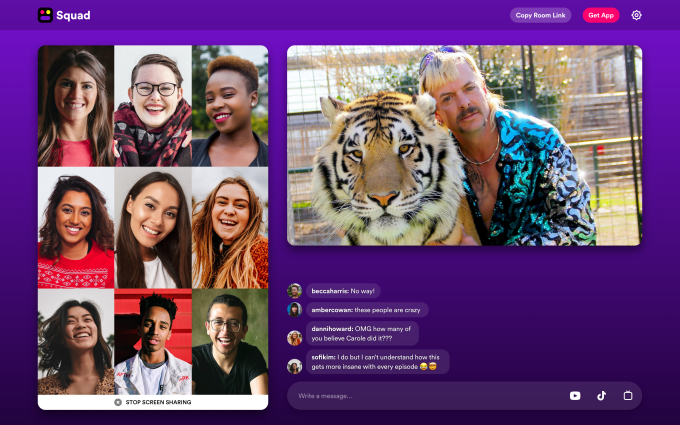
The screen-sharing mobile app Squad has Houseparty ambitions. The app maker this week revealed it saw a 54% boost in usage due to the coronavirus quarantine in the first two weeks of March, followed by a 1,100% jump in March’s last two weeks. To date, its social platform has been designed around watching friends browse their phone virtually — a way for kids to watch TikTok together or browse Instagram, perhaps. This week, the app expanded to the desktop to allow users to binge TV and movies together as well.
Marco Polo
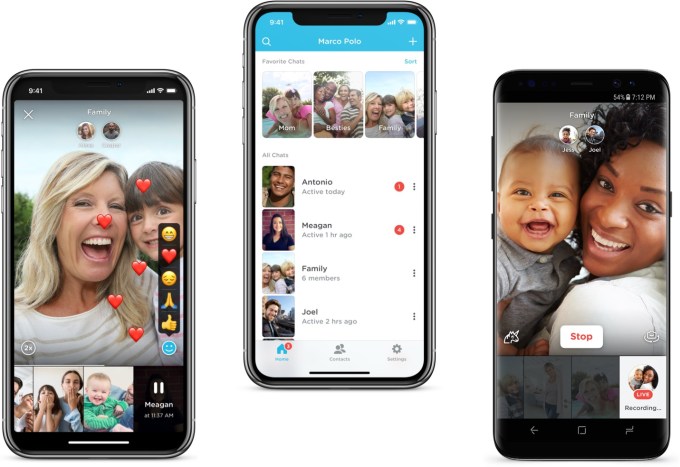
If you don’t have a ton of time to hang around on social video group chat apps, the asynchronous video messaging app Marco Polo may be a better fit. It’s also better for people in different time zones or who have different work schedules that would otherwise prevent them from talking in real time.
This week, Marco Polo introduced an optional subscription in an effort to better monetize its service amid growing usage triggered by the coronavirus pandemic. The offering, Marco Polo Plus, includes support for HD video, voice-only messaging options, custom emoji, expanded speed controls and more — for $5 per month with an annual subscription of $59.99.
Shopify’s Shop
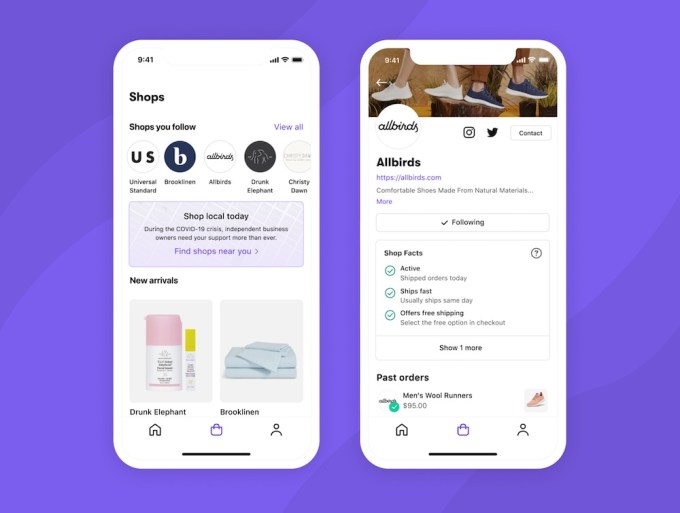
E-commerce platform Shopify this week launched a new consumer-facing app called Shop, a rebrand of its earlier Arrive app for package tracking. The new app allows consumers to browse a feed of recommended products, learn more about each brand and make purchases using the one-click Shop Pay checkout process. However, it still includes the package-tracking feature. Package tracking, by the way, is having a really great April.
Arrive had been leading this market, Apptopia reported.
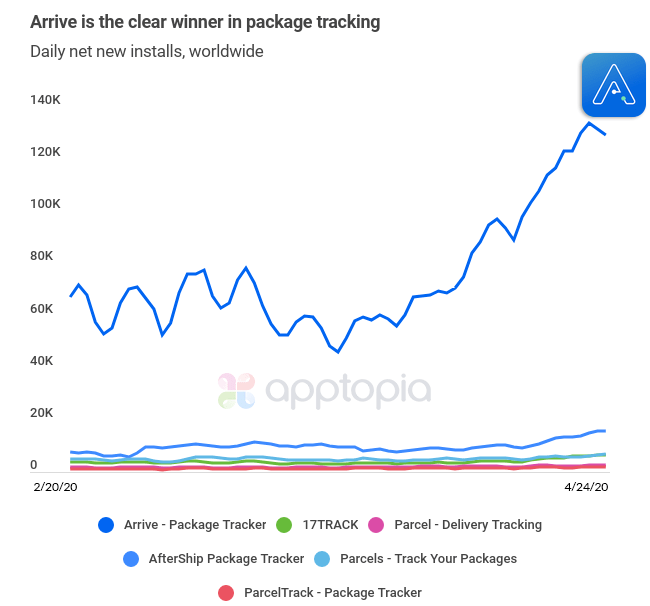
Food Network Kitchen
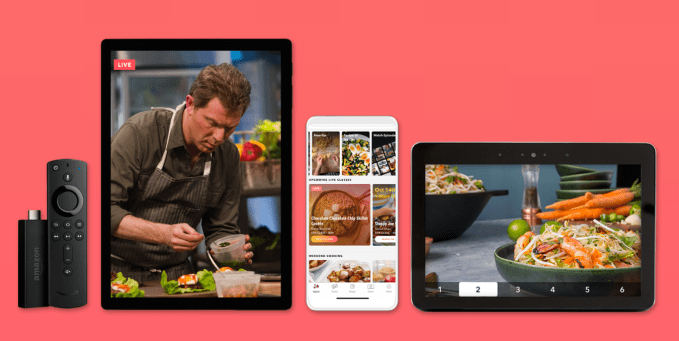
The subscription service offering recipes, on-demand video and even interactive live cooking classes with celeb chefs is a great quarantine companion. And now it’s free for a year to some Amazon device users. Amazon is subsidizing a year’s worth of Food Network Kitchen for Amazon Fire TV and Fire tablet owners across the U.S., thanks to an expanded collaboration with Discovery.
Typically, Food Network Kitchen sells for $4.99 per month or $39.99 per year, according to its website.
- This episode of the “Deconstructor of Fun” podcast talks to App Annie about the impact of coronavirus on mobile apps.


